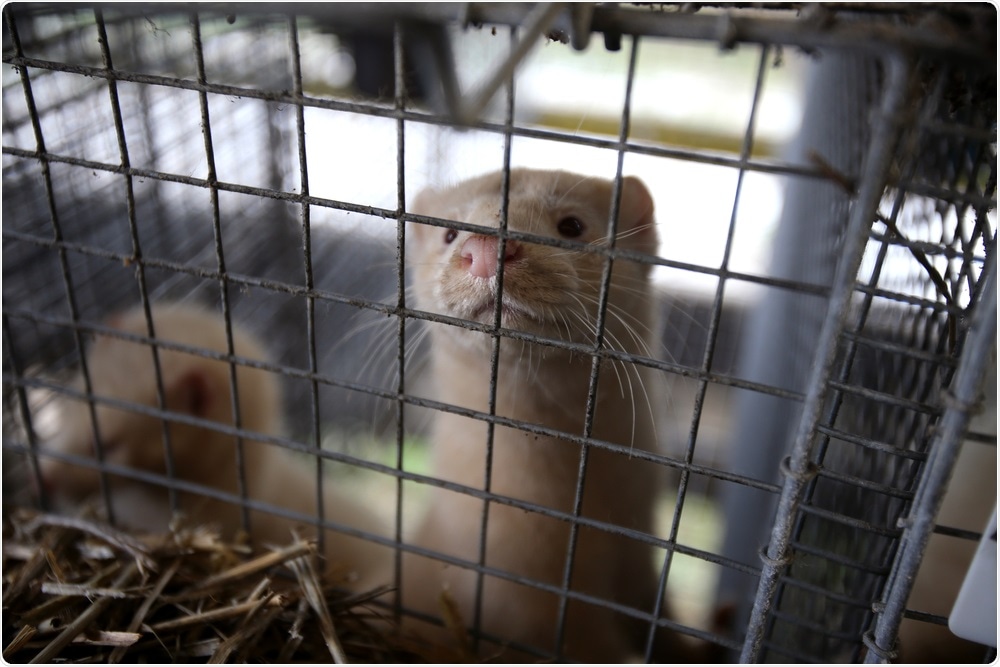Early in the coronavirus disease 2019 (COVID-19) pandemic, several reports found that minks on various farms had become infected with the severe acute respiratory syndrome coronavirus 2 (SARS-CoV-2). A new study published in PLOS Pathogens finds that farmed mink not only acquire the infection and freely transmit it among themselves but also were reinfected after two months, despite being seropositive.
 Study: Infection, Recovery and Re-Infection of Farmed Mink With SARS-CoV-2. Image Credit: Algimantas Barzdzius / Shutterstock.com
Study: Infection, Recovery and Re-Infection of Farmed Mink With SARS-CoV-2. Image Credit: Algimantas Barzdzius / Shutterstock.com
The farm, Farm 4, which was reported in this study, was the first Danish mink farm that allowed infected animals to recover from SARS-CoV-2 infection, being repeatedly tested thereafter in order to record their immunity and reinfection correlate. At about two months from the initial infection, no traces of the virus were found.
“Thus, Farm 4 gave a unique opportunity to follow the maintenance of anti-SARS-CoV-2 antibodies over an extended period and the resistance of the animals to reinfection.”
Study findings
The current study was carried out on Farm 4 in Denmark with about 15,000 animals, of which about 75% were infected with SARS-CoV-2 as shown by the presence of viral genetic material in throat swabs. All infected animals were seropositive.
The infecting virus had a deletion at H69 and V70 residues within the gene encoding the SARS-CoV-2 spike protein, as well as the Y453F substitution that has already been seen in mink. Despite the fact that all the viral isolates were closely related, additional mutations were seen in two of the first outbreak viruses. The viruses found during the second outbreak formed another branch with further mutations.
Unlike other mink farms, the animals were allowed to recover, having shown little evidence of disease and few having died. Following recovery, the mink were found to be seropositive, which was confirmed by the results of 300 randomly tested animals. These animals remained virus-free for more than two months, at which point a fresh outbreak occurred.
During this second round of infection, more than 75% of the mink, both those that died and the living animals, were positive for the viral ribonucleic acid (RNA) genome by polymerase chain reaction (PCR) testing of throat swabs. The viruses responsible for this outbreak were closely related to those isolated in the first epidemic but with additional changes.
Antibody testing showed much higher antibody levels this time around, thereby indicating that the second infection acted as a booster of immunity. This indicates that seropositive mink were readily re-infected by the virus.
Implications
The fact that SARS-CoV-2 changed its sequence during the period between the two outbreaks, forming a distinctive branch from the virus found during the first outbreak on other farms, while remaining most closely related to the virus found earlier on the same farm, shows continuing replication was occurring during this period. It is unknown whether the altered virus came from outside the farm, from an alternative host linked to the farm, or was from the farm itself, having been formed by continuing replication in a small subset of the animals but without significant transmission.
The virus circulating during the first outbreak, with the ΔH69/N70 and Y453F changes, were found in a cluster of humans in the local community during that time, while one case of human infection with the second-wave virus was also identified. Both of these cases appear to have originated from the mink.
The double deletion ΔH69/N70 was first seen in mink on this farm and has since been identified in several human variants of the virus. This spike deletion doubles the infectivity of pseudoviral particles bearing the mutant spike compared to the wildtype and appears to be a secondary change, following other mutations. No changes other than the silent C>T mutations had occurred in the spike protein between the two rounds of infection, though other parts of the genome were affected.
The puzzlingly high incidence of reinfection on this farm, despite the 100% seropositivity of infected animals before the second outbreak, remains unexplained. However, some postulate that the antibodies detected could possibly be due to maternal antibodies derived by transplacental transmission, which might wane more rapidly than those generated by natural infection. A powerful argument against this is the throat swab positivity of the mink in over 80% of cases, which indicates that most of the kits were infected during the first wave.
Transmission could occur through fomites such as feed, bedding, and air, since the cages were of wire netting and are side by side in long rows, allowing nose contact between animals in adjacent cages.
It would appear that farmed mink do not derive permanent immunity to SARS-CoV-2 after infection, though this is not the case with many other species including rhesus monkeys and humans, for the most part.
Another reason for the reported reinfection could be that farm conditions allow a high dose of the virus to reach previously infected animals once the virus begins to replicate in some of them. This could potentially overcome the immune response.
Two doses of a spike-based vaccine conferred immunity in the mink against viral challenge at five weeks; however, the duration of such protection remains unknown.
The antibody response to both rounds of infection was neutralizing in nature, with the second-round samples clearly showing a boosted immune response due to reinfection. The boosted antibody levels following the second round of infection might imply an inadequate immune response to the first infection that allowed viral replication to continue. In elderly humans in Denmark, only half were found to be protected against reinfection, strengthening this supposition.
Therefore, there remains a need to identify what immune parameters correlate with immune protection in mink. It seems clear that mink present a reservoir for the replication of the virus, from which it can spread to mink as well as to humans, and vice versa.